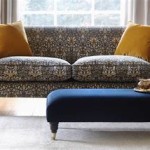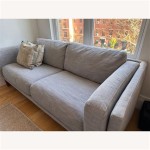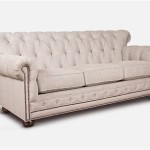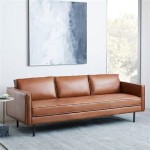Which Color Goes With a Brown Sofa: A Comprehensive Guide
A brown sofa serves as a versatile and grounding element in interior design. Its neutrality allows for a wide range of complementary colors, making it a popular choice for living rooms, dens, and even home offices. The success of integrating a brown sofa into a space, however, lies in understanding the nuances of color theory and how different hues interact with the specific shade of brown, the existing decor, and the desired ambiance.
This article will explore various color palettes that harmonize effectively with brown sofas. It will delve into the considerations surrounding the undertones of the brown, the impact of lighting, and the overall aesthetic goals of the room. From cool and calming to warm and inviting, the information presented aims to provide a thorough understanding of color pairings with brown furniture.
Understanding the Undertones of Your Brown Sofa
Brown is not a monolithic color. It encompasses a spectrum of shades, each possessing different undertones. Identifying these undertones is crucial for selecting the most harmonious color palette. Undertones are the subtle hues that influence the overall perception of the color. A brown sofa may exhibit warm, cool, or neutral undertones. Warm undertones lean towards red, orange, or yellow, while cool undertones lean towards blue, green, or gray. Neutral browns tend to lack a dominant undertone, making them the most versatile but also potentially requiring more consideration in pairing.
To determine the undertone, compare the sofa to a pure white object under natural light. If the brown appears slightly reddish or yellowish, it has warm undertones. If it appears slightly bluish or grayish, it has cool undertones. If the brown seems unchanged by the white object, it is likely a neutral brown.
Matching these undertones in complementary colors will create a cohesive and balanced aesthetic. For example, a brown sofa with warm undertones will pair well with colors that also possess warm undertones, such as golds, reds, oranges, and warm greens. Conversely, a brown sofa with cool undertones will harmonize with colors that possess cool undertones, such as blues, grays, purples, and cool greens.
Ignoring the undertones can result in a clash, creating a visually jarring effect. While intentional clashes can be used for a bold and eclectic look, achieving this requires a deep understanding of color theory and careful execution. For most spaces, a harmonious and balanced palette is preferable.
Exploring Complementary Color Palettes
Once the undertones of the brown sofa have been identified, it is possible to explore specific color palettes that complement it effectively. Several popular and successful color combinations exist, each offering a distinct aesthetic.
Neutral Palette: A neutral palette focuses on incorporating various shades of beige, cream, gray, and white. This approach creates a sophisticated and calming atmosphere. To avoid a monotonous look, introduce texture and visual interest through different materials, such as woven throws, plush rugs, and patterned cushions. Consider using varying shades of the same neutral color to add depth and dimension to the space. For example, a dark brown sofa could be paired with light beige walls and cream-colored accents.
Earthy Palette: An earthy palette incorporates natural colors like greens, blues, and terracotta. This approach creates a warm and inviting space reminiscent of the outdoors. Greens evoke a sense of tranquility and can be incorporated through plants, artwork, or wall paint. Blues add a touch of coolness and sophistication, while terracotta provides warmth and grounding. For example, a brown sofa could be paired with olive green walls, a denim blue rug, and terracotta-colored cushions.
Jewel-Tone Palette: A jewel-tone palette utilizes rich, saturated colors like emerald green, sapphire blue, ruby red, and amethyst purple. This approach creates a luxurious and dramatic aesthetic. These colors work particularly well with dark brown sofas, providing a striking contrast. However, it is important to use jewel tones sparingly to avoid overwhelming the space. They can be incorporated through accent pieces, such as cushions, throws, or artwork. For example, a dark brown sofa could be paired with emerald green cushions, a sapphire blue rug, and ruby red artwork.
Monochromatic Palette: A monochromatic palette utilizes different shades and tints of the same color. This approach creates a cohesive and sophisticated look. To avoid a flat and uninteresting space, incorporate textures and patterns. For example, a light brown sofa could be paired with darker brown walls, a beige rug, and cream-colored cushions with a subtle pattern. The key to success with a monochromatic palette is layering different tones and textures to create depth and visual interest.
Contrast Palette: A contrast palette involves pairing colors that are opposite each other on the color wheel. This approach creates a vibrant and energetic space. For example, a brown sofa could be paired with blue walls and orange accents. However, it is important to use contrast palettes carefully, as they can be visually stimulating and potentially overwhelming. Balance is key; ensure that one color is dominant and the other is used as an accent.
Considering Lighting and Room Size
The impact of lighting and room size on color perception should not be underestimated. Both natural and artificial light can significantly alter how colors appear. Colors tend to appear warmer under incandescent lighting and cooler under fluorescent lighting. Natural light can wash out colors, especially in brightly lit rooms. Therefore, it is important to test paint samples and fabric swatches under different lighting conditions before making a final decision.
In smaller rooms, lighter colors tend to make the space feel larger and more airy. Darker colors, on the other hand, can make the space feel smaller and more intimate. For a small room with a brown sofa, consider using lighter shades on the walls and incorporating pops of color through accent pieces. In larger rooms, darker colors can be used to create a sense of warmth and coziness. A larger room can accommodate a darker brown sofa and richer, more saturated wall colors.
The direction of natural light also plays a role. Rooms that face north tend to receive cooler, more diffused light, while rooms that face south receive warmer, more direct light. This can influence the perception of color and should be taken into consideration when selecting a color palette. In north-facing rooms, consider using warmer colors to counteract the coolness of the light. In south-facing rooms, consider using cooler colors to balance the warmth of the light.
Reflective surfaces, such as mirrors and glossy paint, can also amplify light and make a space feel brighter. Matte surfaces, on the other hand, absorb light and create a softer, more subdued atmosphere. Consider the existing finishes in the room and how they interact with light when selecting a color palette.
Ultimately, the best color palette for a room with a brown sofa will depend on the specific space, the desired aesthetic, and the individual preferences of the occupants. Experimentation and careful consideration are key to creating a harmonious and visually appealing environment. Before committing to a particular color scheme, consider creating a mood board or using online design tools to visualize the space and ensure that the chosen colors work well together.
By understanding the nuances of color theory, considering the undertones of the brown sofa, and accounting for the impact of lighting and room size, it is possible to create a space that is both beautiful and functional. The versatility of a brown sofa allows for a wide range of creative possibilities, making it a valuable asset in any interior design project.
Remember that personal preference is paramount. While guidelines and suggestions can be helpful, the ultimate goal is to create a space that reflects individual style and creates a comfortable and inviting atmosphere.

What Color Goes With A Brown Leather Sofa Studio34

Your Ultimate Guide To Styling A Brown Sofa Center

What Color Go With Brown Sofa Quora

10 Brown Sofa Combinations Ideas Living Room Decor

Secrets From Our Color Expert How To Style Brown Furniture The Roomplace

Your Ultimate Guide To Styling A Brown Sofa Center

What Colors Go With Brown 19 Stunning Color Pairings
18 Stunning Ways To Decorate With A Brown Sofa

Ideas For Wall Colors That Go With Brown Furniture The Inside

What Colors Go With Brown 19 Stunning Color Pairings








